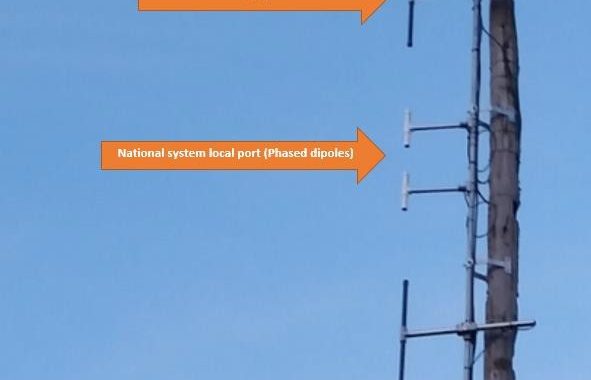The last two Friday’s have seen a substantial amount of work at the Marley’s Hill site. All the old chain clamps are now long gone on the upper pole. We have replaced the old Diamond X50 antenna with 4 dipoles, run all new feeders to the hut, tweaked the duplexer tuning, labelled all the feeders so we will know what’s where in 10 years time.
Having completed the work on Friday 18th August, Richard ZL4FZ measured the performance of the repeater. The results are consistent with the changes we have noted over the last few visits so I thought a summary of the total effect (from temporary dipole to final configuration) would be of help.
In summary, January 2016 (using the X50 antenna)
- The signal received from 705 using a fixed antenna at my QTH was -53 dBm (with the transmitter running at 100W).
- To trigger 705 (with CTCSS tone), I needed – 11 dBm from a signal gen to open the mute, but needed 5 dB more (-6 dBm) to hold the repeater on and hear the test tone (because of 5dB de-sensing of the repeater receiver by it’s Tx and site noise).
18th August 2017 (using new antennas).
- The signal received from 705 on the same antenna at my QTH is – 47.5dBm (with the transmitter running at 58 W).
- To trigger 705 (with CTCSS tone), I need -17 dBm from the sig gen to open the mute, and 2dB to hold the repeater on and hear the test tone (i.e. 2dB de-sense).
Performance change
- The effective increase in transmit performance is 5.5 dB (signal level) plus a 2.4 dB reduction in Tx power required to stay legal =7.9 dB .The effective increase in receive performance (including the effects of de-sense) is a 9dB improvement in usable sensitivity.
- Ignoring the de-sense improvement, the receive performance is 6 dB better than before (i.e. antenna changes only).
- The repeater receiver improvement is equivalent to a 5 W hand- held being able to transmit using 40 W !
- On the receive side (mobile or hand-held), to get the same the 5dB increase in transmitted signal level in Christchurch, we would have had to run the repeater transmitter at 316 W instead of 100 W. Instead we have had to reduce the Tx power to 58 W to stay within our 200 W EIRP license.
- Of course this is not all due to the antenna changes. Touching up the duplexer tuning has made a 3 dB improvement in de-sense, complimenting the increased antenna receive gain.
- Please continue to test so we can assess the real-world impact, although early indications are consistent with the results above (Jim – 3ND was able to use HH at Methven from kitchen window, HH’s in ChCh with much better repeater signals etc)
The VHF repeaters have been measured (off air from Richard ZL4FZ’s QTH) with the following results
| Repeater | RX | TX |
| 705 | Rx (with CTCSS -17 dBm/-15 dBm = 2 dB de-sense) | Tx Signal -47 dBm |
| 725 | Rx (with CTCSS -14/-12.7 = 1.3 dB de-sense) | Tx signal = -62 dBm (Improved by 17 dB Tx and 15 dB more sensitive Rx c.f. results from about 2 years ago – another good antenna job). |
| 675 | Unable to measure Rx sensitivity today | Tx signal -71 dBm – within normal fading tolerance for this path (last was -75dBm) |
| 6975 | Unable to measure Rx sensitivity today | Tx signal -85 dBm – within normal fading tolerance for this path (last was -88dBm) |
| 5625 | Unable to measure Rx sensitivity today | Tx signal -68 dBm – within normal fading tolerance for this path (last was -72 dBm) Repeaters I could not measure require more than 0dBm to trigger – test set can only do 0dBm max (When I fix HP Test set it will do +20 dBm). |
Author Richard ZL4FZ


